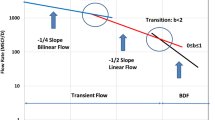Abstract
Decline curve analysis (DCA) is a traditional method for production prediction, which is still being used because it works in many cases and it is relatively simple to apply. However, DCA methods can neither match nor predict the fluctuating oil production during the early period when applied to entire reservoirs. The change in oil production may be because of variation in production conditions or the number of injection/production wells. In this study, we focused on the latter problem, change in the number of production wells. Obviously, there would be a significant oil production boost during a specific time period if more oil wells are drilled. The traditional DCA approach cannot match the increase in oil production due to the increase in the number of oil production wells. We have developed a method to match the oil production of entire reservoirs for the life span by considering the change in the number of production wells. The main idea of this approach came from the concept of effective wells. We applied this approach in several sandstone oil reservoirs with different permeabilities. The proposed effective-well model could match the oil production data in different reservoirs, even during the early period of production when the oil production rate change with time because of the variation in the number of producers. Comparison with the existing models (exponential, hyperbolic model, and harmonic models) was made and the results showed the proposed approach had the best fit to the production history in the cases studied.
Similar content being viewed by others
Abbreviations
- D 0 :
-
Initial decline rate
- n :
-
Decline index
- Q :
-
Oil production rate
- Q 0 :
-
Initial oil production rate
- Q c :
-
Computed oil production rate of entire reservoir
- Q EFF :
-
Oil production rate of effective well
- R 2 :
-
Determinant of coefficient
- SSR:
-
Sum of squared residuals
- t :
-
Production time
References
Agarwal, R.G., Gardner, D.C., Kleinsteiber, SW., Fussell, D.D.: Analyzing Well Production Data Using Combined-Type-Curve and Decline-Curve Analysis Concepts, pp. 478–486. SPEREE, Denver (1999)
Agbi, B., Ng, M.C.: A numerical solution to two-parameter representation of production decline curve analysis, SPE 16505, presented at the SPE Petroleum industry applications of microcomputers, Montgomery, 23–26 June 1987
Araya, A., Ozkan, E.: An account of decline-type curve analysis of vertical, fractured, and horizontal well production data, SPE 77690, presented at the 2002 SPE annual technical conference and exhibition, San Antonio, 29 Sept–02 Oct, 2002
Aronofsky J.S., MasseL. Natanson. S.G.: A model for the mechanism of oil recovery from the porous matrix due to water invasion in fractured reservoirs. Trans. AIME 213, 17–19 (1958)
Arps J.J.: Analysis of decline curves. Trans. AIME 160, 228–247 (1945)
Baker, R.O., Spenceley, N.K., Guo, B., Schechter, D.S.: Using an analytical decline model to characterize naturally fractured reservoirs, SPE 39623, presented at the 1998 SPE/DOE improved oil recovery symposium, Tulsa, 19–22 Apr 1998
Camacho-V., R.G., Raghavan, R.: Boundary-dominated flow in solution gas-drive reservoirs. pp. 503–512. SPEREE, Denver (1989)
Chen H.Y., Poston S.W.: Application of a pseudotime function to permit better decline-curve analysis. SPE formation evaluation 4(3), 421–428 (1989)
Da Prat G., Cinco-Ley H., Ramey H.J. Jr.: Decline curve analysis using type curves for two-porosity systems. SPEJ. 21(3), 354–362 (1981)
Duong, A.N.: A new approach for decline-curve analysis, SPE 18859, presented at the 1989 SPE production operations symposium, Oklahoma, 13–14 Mar 1989
Ehilg-Economides, C.A., Ramey, H.J., Jr.: Transient rate decline analysis for wells produced at constant pressure, SPEJ, pp. 98–104 (1981)
Fetkovich, M.J.: Asimplified approach towater influx calculations-finite aquifer systems, JPT. 23(7), 814–823 (1971)
Fetkovich, M.J.: The isochronal testing of oil wells, SPE 4529 presented at the SPE 48th annual fall meeting, Las Vegas, 30 Sept–3 Oct 1973
Fetkovich M.J.: Decline curve analysis using type curves. JPT. 32(6), 1065–1077 (1980)
Fetkovich, M.D., Guerrero, E.D., Fetkovich, M.J., Thomas, L.K.: “Oil and gas relative permeabilities determined from rate-time performance data. SPE 15431, presented at the 61st SPE annual technical conference and exhibition, New Orleans, 5–8 Oct 1986
Haavardsson N.F., Huseby A.B.: “Multisegment production profile models—a tool for enhanced total value chain analysis. J Pet Sci Eng 58(1–2), 325–338 (2007)
Lefkovits H.C., Matthews C.S.: Application of decline curves to gravity-drainage reservoirs in the stripper stage. Trans. AIME 213, 275–280 (1958)
Li K., Horne R.N.: Characterization of spontaneous water imbibition into gas-saturated rocks. SPEJ 6(4), 375–384 (2001)
Li, K.,Horne, R.N.: An analytical scaling method for spontaneous imbibition in gas-water-rock systems. SPEJ, 9(3), (2004)
Li, K., Horne, R.N.: An analytical model for production decline curve analysis in naturally fractured reservoir. SPEREE 8(3), 197–204 (2005)
Li, K., Horne, R.N.: Comparison and verification of production prediction models. J Pet Sci Eng. doi:10.1016/j.petrol.2006.08.015 (2006)
Li, K., Horne, N.R.: Modeling of oil production by gravity drainage. J Pet Sci Eng. doi:10.1016/j.petrol.2007.06.002 (2007)
Marhaendrajana, T., Blasingame, T.A.: Decline curve analysis using type curves—evaluation of well performance behavior in a multiwell reservoir system. SPE 71517 presented at the 2001 SPE annual technical conference and exhibition, New Orleans, 30 Sept–3 Oct 2001
Masoner, L.O.: Decline analysis’ relationship to relative permeability in secondary and tertiary recovery. Paper SPE 39928, presented at the 1998 SPE Rocky mountain regional/low permeability reservoirs symposium held in Denver, 5–8 Apr 1998
Orodu O.D, Tang Z., Fei Q.: Application of prediction models to performance of high paraffinic content oilfields: case study Shen95 block of Jinganbao oilfield. J Pet Sci Eng 68(3–4), 223–234 (2009)
Palacio, J.C., Blasingame, T.A.: Decline curve analysis using type curves—analysis of gas well production data. Paper SPE 25909 presented at the 1993 Joint Rocky mountain regional/low permeability reservoirs symposium, Denver, 26–28 Apr 1993
Raghavan R.: Well Test Analysis. PTR Prentice Hall, New Jersey (1993)
Author information
Authors and Affiliations
Corresponding author
Rights and permissions
About this article
Cite this article
Li, K., Guan, Y. Effective-Well Method for Matching and Predicting Oil Production. Transp Porous Med 91, 377–389 (2012). https://doi.org/10.1007/s11242-011-9850-6
Received:
Accepted:
Published:
Issue Date:
DOI: https://doi.org/10.1007/s11242-011-9850-6




